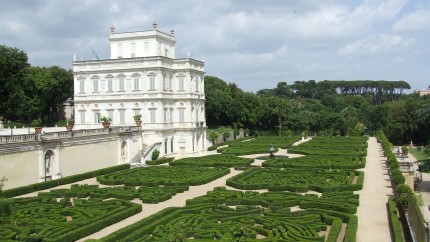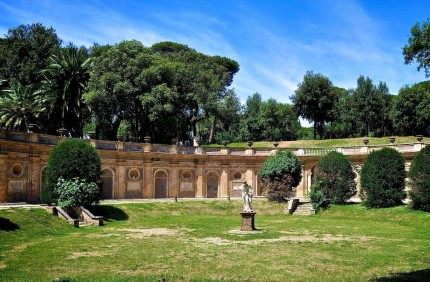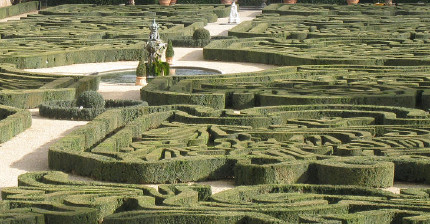Villa Doria Pamhili - The Green Gem of Rome

Behind the name of Villa Doria Pamphili lies one of Rome’s biggest, greenest and, paradoxically, well-known and public secrets. Villa Doria Pamphili is a seventeenth-century Italian villa, accompanied with the largest landscaped public park in Rome. To reach these green lungs of Rome, you’ll just have to leave the ancient walls of Rome through the Porta San Pancrazio, set your feet on the old road of the Via Aurelia, and just in a moment, just outside the city walls, in the Gianicolo district, lies the biggest public Roman park of 184 hectares. As the name says, the Villa emerged as an estate of the noble Roman family of the Pamphili in the seventeenth century. When the line died out a century later, Villa and all its surroundings passed ownership to Prince Giovanni Andrea IV Doria. Prince Doria was not only granted the rights through the marital line to carry Pamphili coat of arms and last name, but he acquired all the Pamphili possessions. Thus, the name Villa Doria Pamphili remained written in history.
As the centuries passed, every owner added its own touch to the look of the Villa. The core of the property, the ‘old villa’ or the Villa Vecchia, already existed before it was bought by Pamfilio Pamphili in 1630. He then set out to expand his newly acquired suburban villa by buying up local vineyards in the neighborhood. Thus, he created a large holding sometimes referred as the Bel Respiro, or the 'beautiful breath'. As it stood on the high ground, the villa and its surroundings truly served as a green lungs, as they were above the malarial areas of Rome. The peak of the Pamphili family power came some fifteen years later, with the election of Giovanni Battista Pamphili, Pamfilio’s brother, as Pope Innocent X. The Pamphili Pope is remembered by his active political role in the 17th century, greatly expanding the power of the Holy See, and participating in major political events of his era, such as English Civil War, First War of Castro and conflicts with the French church officials.

Years passing by, the Villa survived all the political turmoil raging through the Europe. After the Pamphili brothers enriched its property with stuccoed and frescoed interiors painted by famous Giovanni Francesco Grimaldi, Inocent’s nephew Camillo Pamphili in 1650’s laid out new gardens on its south side, known as the giardino segreto or ‘secret garden’. At that time, the Fountain of Venus by Alessandro Algardi was erected as well. Features were added throughout the whole 18th century, such as fountains and gateways. As the Napoleonic era passed, more drastic changes were made in a manner of remodeling outer gardens similar to the fashion of the English landscape gardens. The Villa’s property contained several Roman tombs and ancient ruins, and they were incorporated into a new scenery inspired by the paintings of Claude and Poussin, depicting idealistic frames of Italian landscapes with Roman ruins.
As the raging flame of the 18th century carried even brighter into the 19th, and escalated during the conflicts surrounding the Roman Republic in 1849–1850, Garibaldi fortified three of the villas on the outskirts of Rome. Thus, Villa Doria Pamphili witnessed some of the bloodiest battles fought between Garibaldi’s legions and French troops at the Porta San Pancrazio. Although some of the neighboring Villa’s were destroyed during the French bombardment, Villa Doria Pamphili was lucky enough to avoid that faith. Not only it survived, but it was doubled in its size when prince Doria-Pamphili in the aftermath of the conflicts bought destroyed neighboring Villa Corsini.

Villa Doria Pamphili prevailed over all the history’s challenges, and was finally bought in 1965–1971 by the City of Rome from the Doria-Pamphilii-Landi family. Today, whole complex has an area of 1.8 km² and besides beautiful park and gardens, hosts rich gallery of art, facilities for bird-watching and tracks jogging. As a vast piece of green and quiet, it serves the same function as London’s Hyde Park, or New York’s Central Park. It’s an intimate getaway from the hectic pace of the city it accompanies. It’s a place where you can escape from all the noise, cars, people, tourists, and, more importantly, it’s a place where city reconnects with nature. In our modern surroundings, where growth of plants is often replaced with the pragmatism of the asphalt, having a green oasis in your city becomes a luxury. And a necessary one.
Illustration sources:
- Photo 1: Rome Hints
- Photo 2: Scoprendo Roma
- Photo 3: Rome Art Lover
